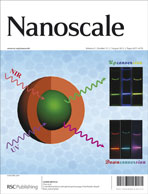A method for preparing multiphasic hollow rods consisting of nanoscale Sn-based materials through a thermochemical reduction process involving bacteria and Sn oxides is reported. This facile process involves the bacteria-mediated synthesis of SnO2 nanoparticles that form on bacterial surfaces used as templates at room temperature. The subsequent template removal proceeds via a reduction of the heat-treated SnO2 nanoparticles at 400 °C under reduction atmosphere, leaving free-standing hollow nanocomposite rods. These unique hollow nanocomposite rods have multiple components, including amorphous carbon, metal oxides (SnO2 and SnO), and metallic Sn, and retain the original rod shapes. The systematic phase and morphological evolutions of the bacteria@SnO2 composite rods are investigated by performing controlled thermochemical reduction at various temperatures. In addition, the application of multiphasic hollow nanocomposite rods as anode materials for rechargeable Li-ion batteries is evaluated. These materials exhibit excellent electrochemical performance, with capacities of about 505 and 350 mA h g−1 at current densities of 157 and 392 mA g−1, respectively.

You have access to this article
 Please wait while we load your content...
Something went wrong. Try again?
Please wait while we load your content...
Something went wrong. Try again?


 Please wait while we load your content...
Please wait while we load your content...